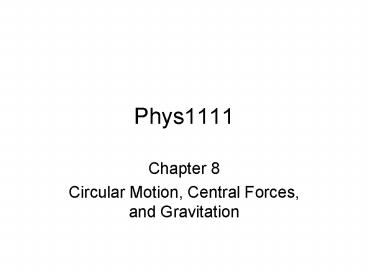Phys1111 PowerPoint PPT Presentation
1 / 15
Title: Phys1111
1
Phys1111
- Chapter 8
- Circular Motion, Central Forces, and Gravitation
2
Circular Motion
- Uniform circular motion
- a body in uniform circular motion moves in a
circle with constant speed - The velocity of the body is always tangent to the
circle - Velocity is not constant because of the change in
direction
3
Circular Motion
In uniform circular motion, both the total force
on an object and the objects acceleration must
be perpendicular to the velocity and toward the
center of the circle.
4
Circular Motion
5
Circular Motion
- Example 1
- A large marry-go-round completes one revolution
every 10.0s. A child of mass 20.0kg is sitting
6.00m from the center. - Compute the acceleration of the child.
- What centripetal force is acting on the child?
Additional Examples Example 8-1, Example 8-2,
Example 8-3
6
The universal law of gravitation
Every particle attracts any other particle with a
gravitational force whose magnitude is given by
m2
m1
r
This equation is called Newtons universal law of
gravitation.
Here m1 and m2 are the masses of the two
particles, r is the distance between them, and G
is the universal gravitational constant. G
6.67x10-11N.m2/kg2
7
The universal law of gravitation
- Example 2
- Two objects exert a gravitational force of
magnitude Fg on each other. By what factor you
multiply the distance between the two objects to - reduce Fg to 1/16 of its original value?
- Increase Fg nine times of its original value?
8
The universal law of gravitation
Gravitational interaction between earth and an
object on or near to its surface
and
m
r
For an object near the surface of the earth r
RE and a g.
ME
RE
9
The universal law of gravitation
Mp
Period of Planets
Ms
R
Ms
Law of periods
10
The universal law of gravitation
- Example 3
- A weather satellite is in a circular orbit about
earth. By what factor will the time required for
a single orbit be multiplied if - The radius of its orbit is doubled?
- Its mass is tripled?
11
Gravitational Potential Energy
m1
r
m2
12
Gravitational Potential Energy
Bound system (KE PE) lt 0
Unbound system (KE PE) gt 0
13
Gravitational Potential Energy
Escape velocity (speed) (ve) Escape velocity or
speed is the minimum speed that an object must be
propelled from an astronomical body ( planet or
moon) in order to escape its gravitational
attraction.
For a rocket of mass m to escape from a planet or
moon of mass M and radius R, its total energy
must be zero at the surface of the planet or moon.
14
The universal law of gravitation
Example 4 Find the escape velocity on earth.
15
Exercises
- 8.10,8.12,8.14,8.21,8.32, 8.37, 8.40, 8.71, 8.80

